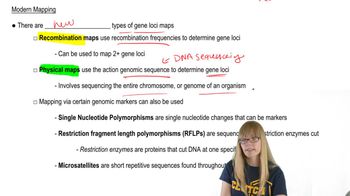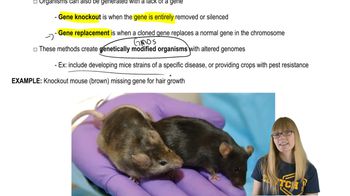Which of the following represents the wobble hypothesis?
Table of contents
- 1. Introduction to Genetics51m
- 2. Mendel's Laws of Inheritance3h 37m
- 3. Extensions to Mendelian Inheritance2h 41m
- 4. Genetic Mapping and Linkage2h 28m
- 5. Genetics of Bacteria and Viruses1h 21m
- 6. Chromosomal Variation1h 48m
- 7. DNA and Chromosome Structure56m
- 8. DNA Replication1h 10m
- 9. Mitosis and Meiosis1h 34m
- 10. Transcription1h 0m
- 11. Translation58m
- 12. Gene Regulation in Prokaryotes1h 19m
- 13. Gene Regulation in Eukaryotes44m
- 14. Genetic Control of Development44m
- 15. Genomes and Genomics1h 50m
- 16. Transposable Elements47m
- 17. Mutation, Repair, and Recombination1h 6m
- 18. Molecular Genetic Tools19m
- 19. Cancer Genetics29m
- 20. Quantitative Genetics1h 26m
- 21. Population Genetics50m
- 22. Evolutionary Genetics29m
11. Translation
Translation
Problem 1c
Textbook Question
How do we know, based on studies of Neurospora nutritional mutations, that one gene specifies one enzyme?
 Verified step by step guidance
Verified step by step guidance1
Understand the historical context: The 'one gene, one enzyme' hypothesis was proposed by George Beadle and Edward Tatum based on their experiments with the bread mold Neurospora crassa. They used this organism because it is haploid for most of its life cycle, making it easier to observe the effects of mutations.
Review the experimental setup: Beadle and Tatum exposed Neurospora spores to X-rays to induce mutations. They then grew the mutated spores on a minimal medium (containing only basic nutrients) to identify mutants that could not grow unless specific nutrients were added.
Analyze the results: They found that some mutants could not synthesize certain amino acids or vitamins on their own. For example, a mutant might require arginine to be added to the medium to grow, indicating a defect in the biochemical pathway for arginine synthesis.
Connect the mutation to the enzyme: By systematically testing which intermediate compounds in the arginine synthesis pathway could rescue the growth of the mutant, they determined that each mutation corresponded to a defect in a specific enzyme in the pathway. This demonstrated that a single gene mutation disrupted the production of a single enzyme.
Conclude the hypothesis: From these observations, Beadle and Tatum proposed the 'one gene, one enzyme' hypothesis, which states that each gene encodes a specific enzyme. This concept has since been refined to 'one gene, one polypeptide' as we now know that not all proteins are enzymes and some proteins are made of multiple polypeptides encoded by different genes.
 Verified video answer for a similar problem:
Verified video answer for a similar problem:This video solution was recommended by our tutors as helpful for the problem above
Video duration:
3mPlay a video:
Was this helpful?
Key Concepts
Here are the essential concepts you must grasp in order to answer the question correctly.
One Gene-One Enzyme Hypothesis
The One Gene-One Enzyme hypothesis, proposed by George Beadle and Edward Tatum, suggests that each gene encodes a specific enzyme that catalyzes a particular biochemical reaction. This concept emerged from experiments with Neurospora crassa, where mutations in specific genes led to the inability to produce certain enzymes, thereby affecting metabolic pathways. This foundational idea in genetics illustrates the relationship between genes and their functional products.
Recommended video:
Guided course

Modern Mapping
Neurospora crassa as a Model Organism
Neurospora crassa, a type of bread mold, serves as a crucial model organism in genetic studies due to its simple genetic makeup and ease of manipulation. Researchers used this organism to investigate the effects of nutritional mutations, which allowed them to link specific genetic mutations to the loss of enzyme function. This model has been instrumental in demonstrating the principles of gene function and metabolic pathways.
Recommended video:
Guided course

Transgenic Organisms and Gene Therapy
Mutational Analysis
Mutational analysis involves studying the effects of specific mutations on an organism's phenotype, particularly in relation to gene function. In the context of Neurospora, researchers induced mutations and observed the resulting nutritional deficiencies, which provided evidence that each mutation corresponded to a specific gene affecting a particular enzyme. This method is essential for understanding gene-enzyme relationships and the biochemical basis of metabolic processes.
Recommended video:
Guided course

Chi Square Analysis

 7:58m
7:58mWatch next
Master Translation initiation with a bite sized video explanation from Kylia
Start learningRelated Videos
Related Practice
Multiple Choice
779
views
2
rank
